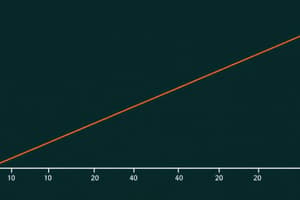Podcast
Questions and Answers
Which of the following is NOT a characteristic investigated by correlation analysis?
Which of the following is NOT a characteristic investigated by correlation analysis?
- The sign of the relationship (positive or negative).
- Whether two variables are related or independent.
- The type of relationship between the variables.
- Establishing causation between the variables. (correct)
A scatter diagram is used in correlation analysis to visualize non-linear relationships between variables.
A scatter diagram is used in correlation analysis to visualize non-linear relationships between variables.
False (B)
Explain why correlation does not imply causation.
Explain why correlation does not imply causation.
Correlation measures the extent of a relationship between two variables, but does not prove that one variable causes the other. They might be linked by a different thing.
In a scatter diagram, the _ variable is plotted on the x-axis.
In a scatter diagram, the _ variable is plotted on the x-axis.
Match the type of correlation with its description:
Match the type of correlation with its description:
What does the coefficient of determination ($r^2$) represent in regression analysis?
What does the coefficient of determination ($r^2$) represent in regression analysis?
A correlation coefficient (r) of -0.9 indicates a weaker relationship than a correlation coefficient of 0.7.
A correlation coefficient (r) of -0.9 indicates a weaker relationship than a correlation coefficient of 0.7.
In the context of hypothesis testing for correlation, what is the null hypothesis ($H_0$)?
In the context of hypothesis testing for correlation, what is the null hypothesis ($H_0$)?
If the calculated t-value in a t-test for correlation exceeds the critical t-value from the t-table at a 0.05 significance level, we ______ the null hypothesis.
If the calculated t-value in a t-test for correlation exceeds the critical t-value from the t-table at a 0.05 significance level, we ______ the null hypothesis.
Match the statistical test with the appropriate sample size condition:
Match the statistical test with the appropriate sample size condition:
Why is it important to test the significance of the correlation coefficient?
Why is it important to test the significance of the correlation coefficient?
Which software can be used to calculate correlation?
Which software can be used to calculate correlation?
State the formula to be used to determine T stat.
State the formula to be used to determine T stat.
What does a line of best fit primarily help to reveal?
What does a line of best fit primarily help to reveal?
The line of best fit is utilized exclusively for determining the precise values of a dataset, leaving no room for estimation.
The line of best fit is utilized exclusively for determining the precise values of a dataset, leaving no room for estimation.
Express the formula for the line of best fit.
Express the formula for the line of best fit.
In the equation for the line of best fit, 'm' represents the ______.
In the equation for the line of best fit, 'm' represents the ______.
In the context of finding the line of best fit, what does the symbol Σ typically represent?
In the context of finding the line of best fit, what does the symbol Σ typically represent?
What is the first step in calculating the line of best fit for a set of (x, y) points?
What is the first step in calculating the line of best fit for a set of (x, y) points?
The y-intercept (b) is calculated before calculating the slope (m) when determining the line of best fit.
The y-intercept (b) is calculated before calculating the slope (m) when determining the line of best fit.
Write the formula to calculate the slope (m) of the line of best fit, given N data points.
Write the formula to calculate the slope (m) of the line of best fit, given N data points.
The formula for calculating the y-intercept (b) of the line of best fit is: b = (Σy − m Σx) / ______
The formula for calculating the y-intercept (b) of the line of best fit is: b = (Σy − m Σx) / ______
Match the component of the line of best fit equation with its definition:
Match the component of the line of best fit equation with its definition:
Flashcards
Correlation
Correlation
A statistical technique that checks the relationship between two or more variables.
Dependent Variable (Y)
Dependent Variable (Y)
The variable of interest that is being predicted or explained.
Independent Variable (X)
Independent Variable (X)
The variable used to predict or explain changes in the dependent variable.
Scatter Diagram
Scatter Diagram
Signup and view all the flashcards
Positive Correlation
Positive Correlation
Signup and view all the flashcards
Correlation Coefficient (r)
Correlation Coefficient (r)
Signup and view all the flashcards
Coefficient of Determination (r²)
Coefficient of Determination (r²)
Signup and view all the flashcards
Coefficient of Determination (r²)
Coefficient of Determination (r²)
Signup and view all the flashcards
Null Hypothesis (H0)
Null Hypothesis (H0)
Signup and view all the flashcards
t-test for Correlation
t-test for Correlation
Signup and view all the flashcards
Z-test for Correlation
Z-test for Correlation
Signup and view all the flashcards
T-test of correlation
T-test of correlation
Signup and view all the flashcards
Regression Analysis
Regression Analysis
Signup and view all the flashcards
Conditional Expectation
Conditional Expectation
Signup and view all the flashcards
Line of Best Fit
Line of Best Fit
Signup and view all the flashcards
Least Squares Regression
Least Squares Regression
Signup and view all the flashcards
y-coordinate
y-coordinate
Signup and view all the flashcards
x-coordinate
x-coordinate
Signup and view all the flashcards
Slope (m)
Slope (m)
Signup and view all the flashcards
Y-Intercept (b)
Y-Intercept (b)
Signup and view all the flashcards
Equation of a Line
Equation of a Line
Signup and view all the flashcards
Σ (Sigma)
Σ (Sigma)
Signup and view all the flashcards
Study Notes
- BTC 801 studies correlation and regression.
Correlation
- Correlation is a statistical method to analyze the relationship between two or more variables.
- It checks if two variables are related or independent.
- It identifies the relationship type (positive or negative).
- It determines the extent of variation in one variable due to changes in another.
- The dependent variable Y is the variable of interest
- The independent variable X influences Y
- The correlation assumes a linear relationship
- Scatter diagrams are used to visualize this relationship.
- The correlation calculation works best for straight-line relationships.
- Correlation does not prove causation, only relationship
- There are three types of correlation: positive, negative, and none.
- Positive means an increase in one variable corresponds with an increase in the other variable.
- Negative correlation means an increase in one variable corresponds with a decrease in the other
- No correlation means there is no relationship
- Correlation values range from -1 to +1:
- 1 means a perfect positive correlation
- 0 means no correlation
- -1 means a perfect negative correlation
Estimation of Coefficient of Correlation (r)
- Calculation for "r" was proposed by Karl Pearson around 1900.
- The coefficient describes the strength of the relationship between variables.
- The coefficient values range from -1.00 to +1.00.
- Values near +/- 1.00 indicate a high correlation.
- Two methods to calculate correlation:
- Direct use of the equation
- Make a table of five columns to find: X, Y, X², XY, then Y²
- After calculating "r": the denominator is always positive, numerator can be positive or negative
- Ranging from -1.00 to +1.00
- "r" has no unit and is a measure of intensity
- It does not determine cause and effect relationships.
Coefficient of Determination
- "r" does not ascribe concrete meaning to the estimated relationship, but the coefficient of determination (r²) does.
- It measures the amount of variability in one variable accounted for by the other, expressed as a percentage.
- r values close to 1 indicate a strong correlation: with r = 0.87, r² = 0.76; therefore 76% of the variation in abdominal length is accounted for by wing length
Testing Significance of Correlation Coefficient
- "r" and "r²" may not always be correct, especially with small units and the null hypothesis must be tested.
- Use a t-test if the number of paired observations is less than 50.
- Use a z-test if the number of observations is greater than 50.
- Z = r/1 divided by the square root of n-1
T-Test of Correlation
- H0: P = 0 (population correlation is zero).
- H1: P ≠ 0 (population correlation is not zero).
- Use t = r * sqrt(n-2) / sqrt(1-r²).
- Check the t-table at a 0.05 confidence interval and 11 degrees of freedom.
- Reject the null hypothesis and accept H1 at a 0.05 level when t calculated is greater than t.
- Software available Excel (CORREL function), LibreOffice Calc, and SPSS.
Regression analysis
- It is a statistical process for estimating relationships among variables.
- It models and analyzes several variables and focuses on the relationship between a dependent variable and one or more independent variables.
- The line reveals how the typical value of the 'criterion variable' changes when any one of the independent variables is varied, while the other independent variables are held fixed.
- Estimates the conditional expectation of the dependent variable given the independent variables when the independent variables are fixed, and is used for prediction and forecasting with usage of a line of best fit.
Line of Best Fit calculation
- Use least squares regression to calculate values m (slope) and b (y-intercept) in the equation of a line.
- y = mx + b, where y = how far up, x = how far along, m = slope/gradient, b = the Y Intercept.
- To find the line of best fit for N points:
- Calculate x² and xy for each (x,y) point .
- Sum all x, y, x² and xy (∑ means "sum up").
- Calculate Slope m: m = (NΣ(xy) – ΣxΣy) / (NΣ(x²) – (Σx)²).
- Calculate Intercept b: b = Σy – mΣx
- Assemble the equation of a line y = mx + b
- Total square of the errors is small ("least squares").
- Straight lines minimize the sum of squared errors
- Each point is connected to a straight bar by springs.
- Least square calculator apps assist in best fit usage.
Studying That Suits You
Use AI to generate personalized quizzes and flashcards to suit your learning preferences.




